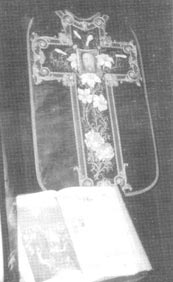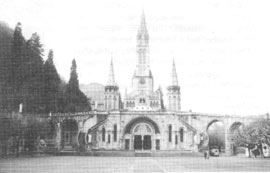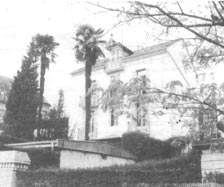Pilgrimage to France
Sara Wright
The big day had finally arrived and there I was waiting in New York's J.F.K. Airport with a group of intrepid pilgrims ready to take a trans World Air night flight to Paris, France, for the Nov. 19, 1989 Solemn Pontifical Mass celebrating Archbishop Marcel Lefebvre's 60 years as a priest.
Most of our group had already assembled and we'd pick up the others tomorrow morning at the hotel in Paris.
First off I met the irrepressible Peggy Lehoux who was to give us many a laugh before the trip was over. Our leader, Mary Helen Parker, was there also.
All told our group would include Alice Brennick and granddaughter, Jennifer Kane, Mr. & Mrs. James Carey, Stephen Cutts, Mr. & Mrs. Eugene Eaton, Mr. & Mrs. Fred Grane, Joanne Schweble, Dr. Eun-Mi Kim with her son, Peter, and mother, Mrs. Paeck from Korea, Angeloi Panzica, Dorothea Scott and Mr. & Mrs. William Young.
Peter would celebrate his 12th birthday on Thanksgiving Day on the train from Lourdes to Paris.
After a night over the Atlantic Ocean we reclaimed our luggage in Paris' Charles de Gaulle airport the next morning and got into the waiting tour bus which whipped by Hotel La Tour Notre Dame to pick up other members of our contingent and also the Rev. Regis Babinet. The Society of St. Pius X's Father Babinet would be with us for the remainder of the tour.
It was a beautiful clear autumn day and our tour bus rolled through the French countryside to Rouen, the first French city and religious site we would visit.
First stop in Rouen was at the Society's St. Francis de Sales Chapel where Father said Mass and then we proceeded to La Goulue for lunch.
In French the name means glutton and it was here we got our first taste of cooking for which the country is famous.
La Goulue was a half timbered house in old Norman style. While we sat a small waitress served course after course including wine and goose and ending with a small cup of coffee.
In our mad dash to reach the bank before closing, we left Peggy. But we went back before she had time to panic and got travelers' checks exchanged for French francs as well.
Then it was on to see Rouen Cathedral painted so many times by Claude Monet and then to the spot where St. Joan of Arc was burned. Regrettably the old monument has been removed and a large modern cross erected instead. Nevertheless we knelt to say three Hail Marys and went in the very modern church adjoining. Father Babinet said St. Joan is the second patron of France.
Afterward a tired group of pilgrims tumbled into Hotel de Dieppe for dinner and a well deserved rest.
The next day was one of the most memorable for me and I believe everyone. We were occupied with St. Therese, loved by both traditionalists and followers of the Vatican II Church.
If possible the weather seemed more beautiful than yesterday and the countryside of Normandy was unforgettable. Our first stop in the charming little town of Lisieux was at the Carmel where St. Therese is buried.
In the museum there we saw her wooden shoes, habit, apron, chasuble she painted, box of paints and the table on which she wrote her autobiography, "The Story of a Soul."
It was hard to believe I was really seeing these things, hard to believe as I climbed the hill to Les Buissonnets that I was really there.
 Lisieux: Chasuble painted by St. Therese at the Carmel. |
Les Buissonnets is the beautiful brick house of the Martin family and the one from which young Therese left to go to the Carmel. We saw her bedroom with the statue of Our Lady that smiled at her during a dangerous childhood illness.
Behind the house is a charming statue of the saint telling her father she wants to enter the convent.
"But she had everything. Why did she join a convent?" I pondered.
Then Bill Young reminded me of other saints who left well to do homes, because they had everything but the one thing money couldn't buy.
Next we visited the beautiful basilica erected to her memory with the garden and graves of her parents behind.
After lunch we went to Alencon where St. Therese's birthplace is now a church.
I was reminded of the first time I saw Chartres Cathedral and what the guide said then, "Chartres does something to the heart."
The sheer immensity leaves one awestruck. To take a photo one must keep stepping back. But it is the windows which are the glory of Chartres.
Leaving Chartres, we arrived in Paris after dark and rushed off to Mass at the Society's Church, St. Nicholas Du Chardonnet. This church, patiently being restored to its former glory, was another of those things I'd only read about and never hoped to see.
The bus was waiting at 8:30 a.m. the next morning to take us to Le Bourget. This is the airfield outside Paris where Charles Lindbergh landed on his transatlantic flight in 1927 and it was here in one of the huge exposition halls that the Archbishop's Mass would be held.
We were very early but already there were crowds, people from different countries with banners proclaiming their towns or nations.
Our group settled on seats and a good thing it was. By the time the Mass actually began about 11 a.m. there were people standing as far as eye could see.
"Have you ever been in a crowd like this?" someone asked.
"Never, " I replied.
Over in the standing area two priests were hearing confessions. Soon they were joined by two other priests.
I decided to join the long lines of people waiting to go to confession. I'd heard one of the priests spoke English.
"If you will speak very slowly," he said in answer to my question as I knelt beside him on the concrete.
Already waiting in line I had agonized about having to confess in French, concluding there is always a first time and if I had to, I would.
I hadn't taken time to get one of the beautiful souvenir programs coming in, so I decided to make a dash outside and try. I got the program all right, but I almost didn't get back to my seat. Ushers were blocking aisles to the seats and with great difficulty I explained I had a seat and my friends were saving it.
Old people, young people, middle-aged people, children, Boy Scouts in blue uniforms with short pants, assembled to honor one man who had seemingly done the impossible and risked everything.
Next day French newspapers grudgingly said truthfully that it was moving. It was magnificent—the music of the sung Mass, the beauty and glory of the ceremony; it was the reason we were all here.
As gracefully as I could, if there is a graceful way to do it, I stood on a chair like others as the procession of small choir boys in red cassocks and white surplices began down the aisle.
Then came the seminarians and priests including Father Babinet. One priest walked with a cane. Another had a long white beard.
There were monks in their habits and sandals with tonsured heads and the four new bishops.
Muted applause signaled the approach of Archbishop Lefebvre, last of all and alone. My impression was of a small man, almost weighted down by his miter with a shy smile and hand raised in blessing.
My mind went back to a day last summer at Ridgefield after the retreat was over, when I had said how much I admire the Archbishop and how much I wanted to see him. A young girl had jumped up from the table and brought back a brochure of this trip. Now it was finally happening. I wasn't the only one moved. I saw men cry.
The altar was beautiful. Standing before us, crook in one hand the Archbishop spoke without notes for quite a long time.
"He has a soft voice," I thought.
The Archbishop gave communion to the choir boys and bishops as the priest accompanied by Boy Scouts headed down the aisles with communion for the thousands assembled. We knelt on the concrete floor at the end of each row to receive.
After the Mass we headed for another of the exposition halls for the dinner. Following a comedy of errors in which we became separated and finally obtained tickets, Mary Helen and I found a table with some empty seats.
I asked one of the young Frenchmen if the seats were taken. They weren't so we took the seats just before grace was said.
Our table mates, all young French people, made the meal enjoyable. An apple cheeked monk was seated next to Mary Helen. He spoke a little English. Proudly he explained from his habit that he was Dominican.
There were small bottles of Champagne at each place and the young man next to me offered to open mine. He poured it in my glass with the cassis to make kir.
A huge cassoulet was set in the middle of the round table and Mary Helen was asked to serve. This was followed by cheese, chocolate pastry and even demitasse, accompanied of course by red wine.
During the long and festive meal the young man next to me explained about the Sacred Heart armbands worn by his group and the Fleur de Lis in his buttonhole.
They "supported the return of a king," he said and he talked about the war in the Vendee in which the peasants had tried unsuccessfully to hold out against the French Revolution.
I asked if it were not true that on occasion Royalist songs were still sung. My dinner companion assured me it was and to prove it he and his friends sang one for me at the table. He also asked if the press in America was as non-objective as in France. I had to agree it was.
There was hardly time to jump up from the table and head for the exposition hall again for Vespers. This time it was Bishop Bernard Fellay who wore the miter in the procession. He seemed almost shy to be in the limelight. As usual the Archbishop followed last, turning with a wide smile.
I had been impressed with the thousands in the morning singing in Latin and knowing it well enough to point the place to me in the program.
Now this afternoon the entrance hymn was a French one, also beautiful, "Je suis Chretien."
I felt a warm glow that one of the small American flags we'd brought and which I'd waved, had been seen and acknowledged by Bishop Richard Williamson.
Others in the hall had seen the flags and been impressed we'd come from so far away to show our loyalty.
 Lourdes Basilica |
Back on the dark bus we compared notes and Peggy said she had spoken with the kissed Bishop Williamson's ring.
Paris had all her well known landmarks lighted as our bus made its way back to our hotel. It wasn't wasted on our group who took photos right and left of the Arc de Triomphe, Eiffel Tower and Les Invalides by night.
We left our hotel in the dark next morning for Gare de Lyon and the train for Nevers and the convent of St. Gildard where St. Bernadette lived from 1866 to 1879.
Her incorrupt body lies in a glass coffin in the Chapel and one of the nuns placed my rosary on top of it. The crucifix and statue of Our Lady before which Bernadette prayed are also in the Chapel.
The grotto of Lourdes has been duplicated outside. From Nevers our bus took us to Paray Le Monial.
It was here in this beautiful old basilica at the Monastery of the Visitation that Saint Margaret Mary received the apparitions of the Sacred Heart.
Time seemed suspended as an old nun wearing the saint's habit came limping in with candles and bowed before the altar. Another was dusting with an old fashioned feather duster.
Leaving the peaceful little town with its winding river, we headed towards Ars. Mass was being said in the basilica but we managed to see the confessionals, separate ones for men and women, where St. John Vianney, the Cure of Ars, spent so many hours of each day.
In his living quarters we saw his partially burned bed, the work of Satan, wooden shoes and a large black hat. Then it was on to Lyon for the night. Bags were left in the hotel rooms and we were off to Mass in the Society's Priory of St. Irenaeus. Afterward we walked back to the hotel in the warm autumn night.
The next morning we took the train for Lourdes. It was to be a momentous day for Dr. Kim. Prior to coming to Paris, she'd had her visa stolen and had to go to the American Embassy before train time to get another. We all said a prayer she'd finish in time to meet us at the train station and she did.
When the train pulled in, the men in our party managed to get all the luggage on handling it bucket brigade style.
We were enjoying the long ride until someone looked while the train was stopped in Valence.
Dr. Kim and Peter were running to get back on our railway car. Seems they had been in another car when it was disconnected and would have been left in the station had they not realized it wasn't moving.
They made it, were greeted with hugs and we got an unexpected bonus. A young man, Steve, was in the same predicament as the Kims and he followed them into our car.
Our schedule called for a change in Toulouse where we'd get another train to Lourdes. Fred went to find out about the train and returned with some unexpected news. The bad news he said was there was a strike on the line from Toulouse to Lourdes. But the good news was that a bus would take us to Lourdes.
 Lourdes: SSPX Priory of Jesus and Mary. |
So with visions of the dinner waiting for us in the hotel in Lourdes, we sat down with sandwiches on the curb to wait for the bus. The bus got us there, albeit two hours later than the train would have and dinner was waiting.
Next morning we set off for the grotto in Lourdes where Our Lady appeared to St. Bernadette. It was a perfect time of year to visit as there were no crowds.
There was a statue of Our Lady in a niche over the grotto at the exact spot where she had appeared to the saint and told her in Basque, "I am the Immaculate Conception." People cured by these miraculous waters had hung their crutches along the grotto and under a heavy piece of glass we could see the actual spring flowing. Some of our group elected to take the baths.
Others like myself settled for drinking the water and carrying some away from the many faucets along the wall.
At noon we attended Mass in the Society's Priory of Jesus and Mary, located in a picturesque hillside spot.
We were free to wander about the little town of Lourdes that afternoon and one gets the feeling it is indeed a holy spot. A beautiful basilica has been erected over the grotto and there are life-size stations of the cross.
I chose to visit St. Bernadette's birthplace, Du Moulin de Boux, and also Les Cachot. The Soubirous family took refuge in the later place after they had lost all their money. It's hard to imagine a smaller, more humble place than Les Cachot, the ancient city prison. Yet St. Bernadette set out from that small room Feb. 11, 1858 to gather wood at the grotto of Massabielle. And it was on that day the Blessed Mother first appeared to her.
We were to take a wagon lit or sleeping car to Paris that night. I was surprised to learn many in our party had never slept on a train.
Confusion reigned with luggage all up and down the aisle, a porter looking as if he'd like to be rid of us and Stephen running about in his sock feet saying, "Isn't this fun."
It was—in spite of the fact my blanket kept falling off and I never could quite figure how to hook the ladder to my top bunk bed.
On arrival in Paris the next morning we visited Notre Dame Cathedral, the museum of martyred foreign missionaries and the Chapel of Our Lady of the Miraculous Medal at 140 Rue du Bac. The chapel is a spot sacred to the memory of St. Louise de Marillac, St. Vincent de Paul and St. Catherine Laboure.
That afternoon we split up with some visiting Sacre Coeur perched high on the butte of Montmartre and St. Chappelle. I went to Cluny Museum with its treasures from Middle Ages.
The next morning after we'd knelt in the hotel lobby to receive Father Babinet's blessing, it was back to the airport and a plane to the United States... the end of a memorable trip and once in a lifetime experience.
Back home I was giving a detailed account of the Mass at Le Bourget to a Novus Ordo friend. "You really felt you'd been to Mass," she said almost with a tone of longing.
